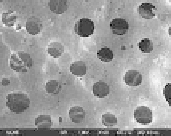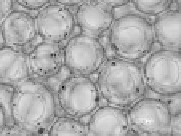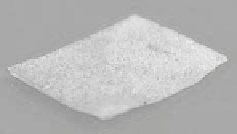Biomedical Engineering Reference
In-Depth Information
Sugar-leached
PLCL scaffold
MSPs
PLCL
Silicon wafer
Neodymium magnet
d)
a)
c)
b)
Figure 8.17
Fabrication process of a sheet-like PLCL scaffold.
MSPs were used to fabricate a sheet-like scaffold. Figure 8.18
shows an overview and surface conigurations of fabricated scaffold.
The self-assembly of MSPs with controlled diameter contributed to
generating effective interspaces where polymer solution iniltrated.
The vacuum-assisted iniltration of PLCL solution was successful and
polymer structure was maintained after whole fabrication process.
The porous coniguration was visible to naked eyes owing to large
pore size. Circular holes observed in Figs. 8.18(b-c) were due to the
contact between MSPs and silicon substrate at the stage of magnetic
attraction. Pores of less than 50
μ
m were also scattered sparsely on
the surface (Fig. 8.18(c)). These small pores are probably due to the
reaction of phase separation among PLCL, chloroform and some
residual hexane.
5 mm
Circular
Hole
5 mm
a) Sheet-like scaffold
500 m
b) Microscope image
of surface
c) SEM image of surface
Figure 8.18
Surface coniguration of sheet-like PLCL scaffolds captured by
optical and electronic microscope.
MSPs 1, MSPs 2 and MSPs 3 shown in Fig. 8.15 were also used to
fabricate PLCL scaffolds. In the same way on previous method, those
sugar particles were cast to PLCL polymer. Figure 8.19 shows the
surface conigurations of PLCL scaffolds cast from MSPs 1, MSPs 2
and MSPs 3. The average diameter and SD of pore size is qualitatively
very close to those of MSPs.










































































Search WWH ::

Custom Search